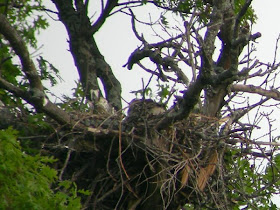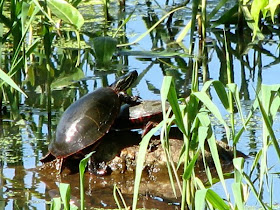 Primus on the left, and Secundus on the right, focus on me. I must have made a move that was suspect in some way.
Primus on the left, and Secundus on the right, focus on me. I must have made a move that was suspect in some way.
 Secundus seems to prefer keeping part of his body hidden while I'm around whereas Primus is much more brazen.
Secundus seems to prefer keeping part of his body hidden while I'm around whereas Primus is much more brazen.
One could say Primus wants to "play", depending on one's particular outlook, one could also say that Primus is menacing Secundus a bit.
I missed the shot but the back feathers blurred with movement is the final phase of a bout of hopping and flapping.
Secundus has retired the right side of the nest where he can peek through two of the large branches which hold up the nest. Note he is looking beak first at this point.
Primus is looking even more feisty. Secundus still peeking, retires further to the right.
Primus prepares for a leap. Secundus no longer peeks.
She decides to do a little flapping and hopping.
(Note: I haven't made any opinion about the eyasses sex, I'm using the male and female pronoun only to help differentiate them. M Mom is more brazen and M Dad is more stealthy and wary, therefore the pronoun given to the youngster that appears currently to have those traits.)
Secundus is back.
Primus appears annoyed. Secundus is back peeking through the branches instead of having a tussle.
Primus looks with focus. At what, I'm not sure. An eyass can be seen between the branches to right who may be drowsing.
Primus checks the perimeter.

And the sky.

And now the famous grown-up hawk look, peering between twigs.
I think she's going to bed down.
Not so fast.
A stern look my way--
And down she goes, and I don't see her pop up again before I leave at 8:37pm CST.
Donegal Browne


























































